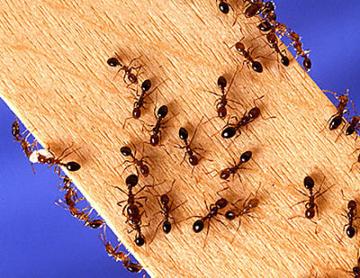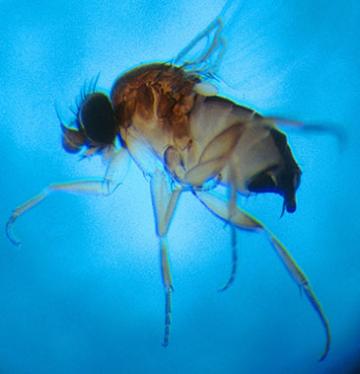Flies + Electricity = Fewer Fire Ants

Red imported fire ants have infested 300 million acres since arriving in the United States in the 1930s. (Photo by Scott Bauer).
Fire ants are a menace in Southern states from east to west and up the Eastern Seaboard to Maryland. They reduce crop yields, injure livestock, damage farm and electrical equipment, and put human lives at risk when stung, from allergic reactions to their venom. The need to control fire ants is clear. But how?
Fire ants will not be eradicated from the United States. They currently infest about 350 million acres, with up to 60 colonies per acre and each colony can have more than 200,000 workers. They reproduce during mating flights that distribute millions of new queens several times a year; this makes control efforts using chemical baits an ongoing effort. Fortunately, researchers from the Agricultural Research Service (ARS) have found an environmentally friendly method to naturally reduce fire ant populations.
They are combining a fire ant’s own pheromones (chemical secretions that act much like hormones) with an imported natural parasite, the phorid fly. The result is a win-win for people and the environment.
Fire ants respond to electrical stimulation by releasing an “alarm” pheromone that activates and attracts both other fire ants and phorid flies, said Bob Vander Meer, research leader with the ARS Imported Fire Ant and Household Insects Research Unit (IFAHI) in Gainesville, FL.
Female phorid flies inject their eggs into the bodies of fire ants. After an egg hatches, the larva moves into the ant’s head, where it feeds and grows. Eventually, it releases an enzyme that causes the ant’s head to fall off. Worker ants consider the severed heads as refuse and take them outside the colony where a new adult fly emerges to repeat the fire ant-phorid fly cycle.

The tiny phorid fly, measuring only about one-sixteenth of an inch, is a specialized predator of fire ants. The female pierces a fire ant's head and releases an enzyme that later decapitates it. (Photo by Sanford Porter)
“Phorid flies are an excellent biocontrol story,” Vander Meer said. “Five different fly species were imported into [our] quarantine facilities (at IFAHI) where experiments conducted by Sanford Porter (ARS retired) confirmed that the flies were specific to fire ants and would not damage plants, crops, or other insects.”
It took decades of effort to rear enough of the flies to release after quarantine into fire ant-infested areas. Researchers estimate that the flies reduce worker populations in fire ant colonies by 10 to 15%.
Vander Meer’s research included how to more efficiently produce enough flies to release across the vast reaches of the fire ant infestation. To do so, he and his colleagues discovered that in the field, electrically stimulated fire ant workers attracted phorid flies, whereas non-stimulated fire ants did not attract the flies.
“We increased the mass rearing efficiency of phorid flies by an ingenious method of … electrically stimulating workers in the phorid fly rearing trays,” Vander Meer explained. “Electrical stimulation released the alarm pheromones from fire ant workers, which activated and attracted the phorid flies in parasitizing the fire art workers. This increased the production of the phorid fly parasites and facilitated the more efficient distribution of the phorid flies throughout the infested area in the United States.”
While phorid flies as a biocontrol agent have been a success, Vander Meer and other researchers at IFAHI are continuing to look for additional new ways to control fire ants.
“We are still investigating fire ant biocontrol with viruses discovered by one of our research entomologists, Steven Valles,” Vander Meer said. “Another exciting project is what we call Receptor-i technology. We are just starting a proof-of-concept experiment using specially selected peptides that strongly bind to a receptor that plays important roles in all life stages of the fire ant. The peptides are species-specific and biodegradable. We think this technology is going to be a major breakthrough,” Vander Meer said.
“Fire ant control is not a once-and-done event,” he added. “It is a continuous struggle.” — by Scott Elliott, ARS Office of Communications
Also in our series on fire ants:

